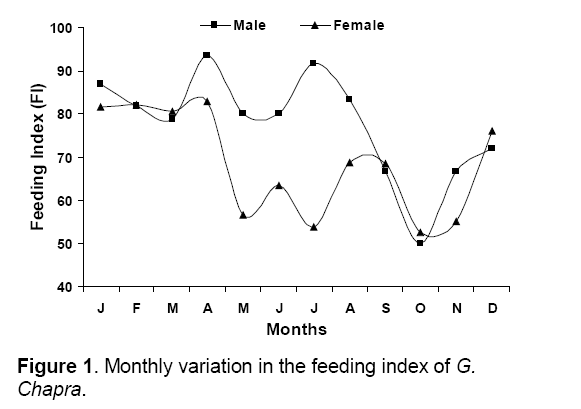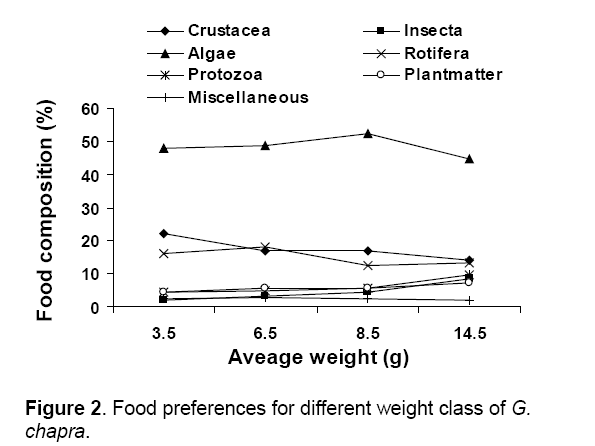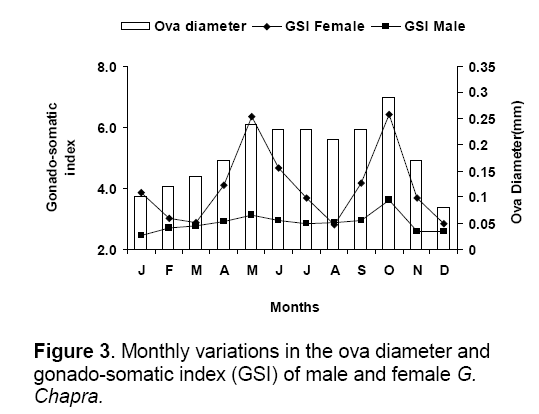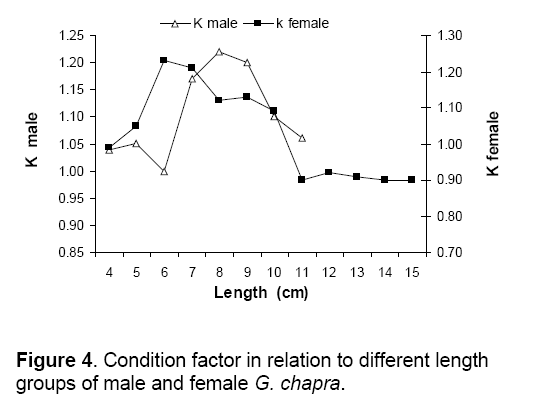Feeding and Reproductive Biology of Indian Shad Gudusia chapra in Two Floodplain Lakes of India
Debjit Kumar Mondal, Anilava Kaviraj
Department of Zoology,University of Kalyani,Kalyani -741235,W.B.,India.
- Corresponding Author:
- Anilava Kaviraj
Tel: +91 (33) 2582 8477
Fax: +91 (33) 2582 8282
E-mail: akaviraj@gmail.com
Abstract
Feeding habit and reproductive biology of Gudusia chapra were studied on specimens captured from two floodplain lakes in India. The fish showed a planktophagus and omnivorous feeding habit, algae constituting bulk of the food item in the gut. Feeding intensity fluctuated between seasons, pre and post spawning months showing higher intensity than the spawning months. Seasonal variation of gonado-somatic index (GSI) and ova diameter indicated that G. chapra spawned twice (May and October) in a year in these two floodplain lakes. Overall ratio between male and female (1:1.56) significantly departed from the expected ratio of sex (1:1). It was concluded that G. chapra exhibited an early maturity under environmental conditions of floodplain lakes and reduced feeding activity could serve as an indicator of spawning activity of the fish.
https://marmaris.tours
https://getmarmaristour.com
https://dailytourmarmaris.com
https://marmaristourguide.com
https://marmaris.live
https://marmaris.world
https://marmaris.yachts
Keywords
Floodplain lake; Gudusia chapra; food; fecundity; spawning.
1. Introduction
Gudusia chapra is a commercially important freshwater clupeid in the freshwater resources of India,Bangladesh and Pakistan [1-3]. Feeding habit [4] and reproductive biology [5] of G. chapra had been extensively studied on specimens captured from Ganges river system in India,where the fish was abundant during early seventies. However,in recent years population of the fish has alarmingly declined in the rivers and reservoirs [2] and its production has been restricted to lakes,ponds ditches,inundated fields [6,7] and other closed water impoundments. Therefore,it is essential to know the biology of G. chapra in these habitats. Although feeding habit has been studied widely on specimens raised in ponds [7-9],there is little information on reproductive behavior of the fish raised in other impoundments.
The floodplain lakes,particularly those which are open and maintain a connection with the river,render a unique habitat for a large number of self-recruiting riverine species of fish. In a recent study,G. chapra has been recorded as one of the eighteen abundant species in two floodplain lakes of North 24 Parganas district of West Bengal in India,in spite of a general trend of decline of finfish species in these lakes [10]. The objective of the present study was to evaluate feeding habit and reproductive biology of G. chapra in these floodplain lakes so that necessary measures,if any,could be taken to make maximum sustained yield of the species in floodplain lakes.
2. Materials and Methods
2.1 Study sites and sampling
Studies were made in two floodplain lakes,Gopalnagar and Dumar,situated on Ichhamati river basin in West Bengal in India. A detailed account of these two lakes has been described previously [10]. Random samples of G. chapra were collected from the monthly catch of fish made from these two floodplain lakes by fine mesh cast nets and gill nets. Altogether six hundred samples were collected over a span of twelve months. Samples of fish collected in each month were assorted into male and female,total length and weight were recorded and dissected to open the viscera. Length of the gut,length of the body cavity,emptiness or fullness of the gut,gonad weight and gonad length were recorded in all the sampled specimens.
2.2 Feeding habit study
The period of intense feeding was determined by calculating the monthly feeding index (FI) using the following formula:
FI = (Number of fishes with food in stomach /Number of fish examined) ×100.
Detailed feeding habit was studied every month on the random samples of 15 specimens with gut completely or partially filled with food materials. Gut contents of the sampled fish were taken out from the anterior portion of the gut in a watch glass. Necessary dilution of the gut content was made with normal saline and it was observed under light microscope using a Sedgwick-rafter cell. Food items were identified up to major taxonomic group.
2.3 Reproductive biology study
The sex ratio was analyzed on total samples of fish by Chi-square test following the equation of Fisher (1970),assuming that the ratio of male and female in the population to be 1:1. The gonado-somatic Index (GSI) was determined using the formula:
GSI = (GW/BW) × 100
Where,GW = gonad weight,BW = body weight of fish.
Fecundity was measured on random samples of 41 matured female fishes ranging from 7.6 to 14 mm in total length and 5.5 to 18.0 g in total weight. Samples taken from the anterior,middle and posterior region of both ovaries were weighed separately and number of mature ova present within each sample was counted. Absolute fecundity was estimated on the basis of total weight of the ovaries using the formula:
F = (Total weight of ovary × N) / weight of the sub sample
Where,F is the fecundity and N is the number of mature ova counted in the sub sample.
Fecundity factor was calculated by dividing fecundity (F) by body weight (BW). The relationships between fecundity and total length,weight,gonad weight and between gonad weight and body weight were determined by the method of least square. Ova diameter was calculated every month on ovaries collected at random from 10 mature fishes. Diameter of the ova was taken out in micron with the help of ocular and stage micrometer and was then converted it into mm. Diameter of 10 ova were measured at random from anterior,middle and posterior region of each ovary and then the mean diameter was calculated. The length at first maturity was determined for males and females by plotting the condition factor (K) of male and female against their length groups following the method of Hart [11]. The condition factor K was calculated using the formula:
K = W × 10M3 / L3
Where,K = condition factor,L = total length of fish,W = total weight of the fish.
3. Results
3.1 Feeding habit
Maximum feeding activity,as revealed from the feeding index,was recorded in April in both the sexes (Figure 1). Feeding intensity reduced thereafter,both sexes showing two more peaks,July and December for male and September and December for female. Feeding intensity in male was significantly higher than female during May to August. The fish showed a preference for herbivorous diet (Figure 2 ). Algae and other plant matters constituted the bulk of the gut content followed by crustacean,rotifers,plant matter,protozoa,insecta and miscellaneous materials.
Among different groups of algae detected in the gut content chlorophycae was the dominant group followed by bacillriophycae. The other important groups were cyanophycae,euglenophycae and dinophycae. A twelve-month average percentage of algae,crustacean,rotifers,plant matters,protozoa,insecta and miscellaneous materials in the gut content were respectively 49.20,18.29,15.70,5.60,5.20,3.60 and 2.60 %. Food preference did not vary between the weight classes. Herbivorous feeding habit was supported from the ratio of total length to gut length (1: 1.76). The relationship between total length (L) and gut length (GL) was significant at P< 0.01 level for both male and female.
3.2 Reproductive biology
The monthly variation of sex ratio of G. chapra has been shown in the Table 1. The ratio between male and female ranged from 1:1 to 1:2.33. The ratio significantly departed from the expected 1:1 ratio in the months of April,August,September,and October (P < 0.05). During these months the females significantly outnumbered the males. The overall sex ratio for the whole sample captured over a period of twelve months also varied significantly from the expected ratio (P < 0.01) with 1.56 female for every male.

The monthly variation of gonado-somatic index (GSI) of male and female G. chapra has been shown in Figure 3 . The GSI of the female ranged from 2.85 to 6.44 and that of male ranged from 2.44 to 3.61,both showing two peaks,one in May (6.35 for female and 3.11 for male) and another in October (6.44 for female and 3.61 for male).
Minimum GSI for female was recorded in December (2.85) and that for male was recorded in January (2.44).The diameter of ova ranged from 0.08 to 0.29mm. Ova diameter also showed seasonal variation with two peaks,which coincided with the peaks of GSI (Figure 3 ).
The fecundity of mature G. chapra ranged from 5795 (with average length 9.5 cm,body weight 10 g and ovary weight 0.7 g) to 26244 (average length 12.2 cm,body weight 15 g and ovary weight 1.9 g). The calculated fecundity factor (1228 eggs /g of body weight) showed that the fish was highly fecund. Fecundity showed significant relationship with body length (L),body weight (W) and gonad weight (GW). The monthly condition factor (K) for males and females of G. chapra in relation to different length groups have been shown in the Figure 4 . There are inflexions on the curve showing K of G. chapra against the length of 5 to 6 cm for females and 7 to 8 cm for males.
4. Discussions and Conclusions
The present study reveals that G. chapra is a planktophagus and omnivorus fish. This is also supported from the gut contents of G. chapra captured from river [4] and those reared in ponds [7]. However,a difference was observed in principal food items of the fish inhabiting river and pond. Jhingran [4] observed planktonic crustacean as the major and regular food items of the fish inhabiting the river Ganges while Alam et al [7] observed detritus and phytoplankton as the principal gut content of the fish when it was reared in pond. Feeding habit is ruled by complex feeding behavoiur mechanism. While the relationship of gut length with the body length strongly favours omnivorous feeding habit of G. chapra,the results of the present study as well as the literatures available reveal that the feeding of this fish is influenced by the availability of the food items. G. chapra is predominantly a surface feeder [12]. Therefore,it is unlikely to obtain detritus in deep water habitat like river [4] and floodplain lakes. However,when the fish was reared in shallow ponds [7] it was easily exposed to the bottom or suspended particles of the bottom. However,the preponderance of planktonic crustacean observed in the gut of G. chapra captured from river Ganges [4] is different from the preponderance of algae in the gut of this fish captured from floodplain lakes. Jhingran [4] observed that the feeding habit of G. chapra changed with the age of the fish. This is in contrast to the observation of almost same feeding habit from very small to large fish in the present study. It is not established if G. chapra has the ability to select a suitable type and size of the food [7] from the medium. The results of the present study and the available literatures indicate that feeding is strongly influenced by the environment of the habitat,particularly the depth of water and abundance of plankton. It is evident from the seasonal variation of feeding index that after an active feeding in April the fish reduces its feeding activity for a couple of months followed by a gradual increase again. This seasonal cycle of feeding activity has been found to be closely associated with spawning activity of the fish.
Sex ratio of G. chapra in the floodplain lakes under study showed a weightage of females over males. Although this is contrast to nearly equal sex ratio (1.16 male: 1 female) of G. chapra observed in a small lake in the catchment of the River Brahamaputra in Bangladesh [3],many other species of small and medium sized fish show a weightage of females over males viz. Rhinomugil corsula [13],Macrognathus pancalus [14],Amblypharyngodon mola [15,16],Botia lohachata [17].
Gonadal development and maturity of fish are reflected in the gonadosomatic index (GSI) of fish. GSI increases with the maturation of fish and decreases abruptly thereafter [18]. The two peaks of GSI and ova diameter indicate that G. chapra breeds twice (May and October) in a year in the floodplain lakes under study. Kabir et al. [19] also observed two spawning peaks for G. chapra,one in April and another in August. This is in contrast to one peak of GSI observed in April for G.chapra in a small lake of Bangladesh [3]. Environmental conditions prevailing in water bodies are important factors that regulate spawning of self-recruiting species like G. chapra. Rahaman and Haque [2] observed that the recruitment pattern of G. chapra in the Rajdhala reservoir in Bangaladesh was composed of two uneven seasonal pulses,one in April-May and another in August-September,while Azadi et al. [20] observed a different seasonal pulse,that occurred in May-July for the same species in another reservoir (Kapati) of Bangaladesh. Our observation of breeding of G. chapra in the floodplain lakes closely agreed with the observation of Rahaman and Haque [2]. Fecundity of G. chapra in the floodplain lakes under study increased with length and weight of the fish. Similar observation had been recorded for G. chapra in two reservoirs of India [21]. Fecundity factor indicates that G. chapra,is a highly fecund fish and it helps the fish to maintain two different spawning season. Obviously ova diameter increased during the late season (October) as compared to early season (May). Determining the length of G. chapra at which first maturity was attained from the point of inflexion on a curve showing K with increase in length [11] it was revealed that the females matured earlier (at 5.1 to 6.0 cm) than the males (at 6.1 to 7.0 cm) in the floodplain lakes under study. Hossain and Ahamed [22] observed first sexual maturity for female G. chapra in the rivers of Bangladesh at 8.00 cm. The implication is that G. chapra matures at an early age in the environment of floodplain lakes. Spawning activity of G. chapra has been found associated with feeding activity. During the active spawning period the fish showed minimum feeding activity,then the feeding activity gradually increased and became maximum before the second spawning. At the end of a spawning period the fish starts recovering the lost weight through gradual increase in feeding activity. This denotes that there is a relation between feeding and breeding activity of G. chapra in the floodplain lakes of Bongaon region. Jhingran [4] also showed a correlation between the feeding habit and changes in the sexual cycle of G. chapra in the Ganges river system.
It is concluded that feeding and reproductive activity of G. chapra varies with the habitat and its prevailing environmental condition. The fish matures at an early age in the environment of floodplain lakes,becomes highly fecund and spawn twice in a year. Reduced feeding intensity could serve as an indicator of spawning activity of the fish in the floodplain lakes.
Acknowledgements
Authors acknowledge the facilities of research provided by Head,Department of Zoology,University of Kalyani and Fishermen Cooperative Society associated with Gopalnagar and Dumar baur.
References
- Narejo N.T.,Jafri S.I.H.,Shaikh S.A.,et al. (2000) Studies on the age and growth of Palri,Gudusia chapra (Clupeidae: Teleostei) from the Keenjhar lake (District: Thatta) Sindh. Pakistan. Pak. J. Zool,32(4): 307-312.
- Rahman M.A.,Haque M.M. (2006) Population Dynamics and Stock Assessment of Gudusia chapra (Hamilton-Buchanan) in the Rajdhala Reservoir,Netrakona,Bangladesh. Asian Fish. Sci,19: 281-292.
- Ahmed Z.F.,Smith C.,Ahamed F.,Hossain Y.,et al. (2007) Growth and reproduction of the Indian river shad,Gudusia chapra (Clupeidae). Folia Zool,56(4): 429-439.
- Jhingran A.G. (1972) Diet composition of Gudusia chapra from Ganga River system,Proc. Indian Natl. Sci. Acad,38(1-2): 94-105.
- Jhingran G.G.,Verma D.N. (1973) Sexual maturity and spawning of Gudusia chapra (Ham) in the Ganges river system. Proc. Indian Natl. Sci. Acad,42: 207-224.
- Rahman A.K.A. (1989) Freshwater fishes of Bangladesh. Zoological Society of Bangladesh. Department of Zoology. University of Dhaka,pp. 364.
- Alam M.T.,Rahmatulla S.M.,Alam M.S.,Rahman M.F.,et al. (2002) Food and feeding habit of Gudusia chapra (Hamilton). Univ. J. Zool. Rajshahi. Univ,21: 41-44.
- Afroz T.,Nabi M.R.,Mustafa G.,et al. (1999) Food and feeding habits of chapila,Gudusia chapra (Hamilton),from Jahangirnagar university ponds. J. Asiatic. Soc. Bangladesh (Sci),25(2): 251-260.
- Narejo N.T. (2006) Study on the food and feeding habit of Palri,Gudusia chapra (Hamilton) from fishpond in Distt: Thatta,Sindh. Pak. J. Zool,38(2): 93-98.
- Mondal D.K.,Kaviraj A. (2009) Distribution of Fish Assemblages in Two Floodplain Lakes of North 24- Parganas in west Bengal,India. J. Fish. Aquat. Sci,4(1): 12-21.
- Hart T.J. (1946) Report on the trawling surveys on the Patagonian continental self. Discovery Reports,23: 223-408.
- Quddus M.M.A.,Rahman O.,Rahman A.,Rahman S.M.M.,Ahmed M.K.,et al. (1991) Food and feeding habits of Gudusia chapra (Hamilton-Buchanan) in a Lake. J. Zool,6: 1-8.
- Mortuza M.G.,Rahman T. (2006) Length-Weight relationship,condition factor and sex – ratio of freshwater fish,Rhinomugil corsula (Hamilton) (Muglliformes: Mugilidae) from Rajshai. Bangladesh. J. Biol. Sci,14: 139-141.
- Suresh V.R.,Biswas B.K.,Vinci G.K.,Mitra K.,Mukherjee A.,et al. (2007) Biology of Amblypharyngodon mola (Hamilton) from a floodplain wetland,West Bengal. Indian J. Fish,54(2): 155-161.
- Afroze S.,Hossain M.A.,Parween S.,et al. (1991) Notes on the size frequency distribution and length-weight relationship of freshwater fish. mblypharygodon mola (Hamilton) (Cypriniformes: cyprinidae). Univ.J. Zool. Rajshahi. Univ,10-11: 103-104.
- Azadi M.A.,Mamun A. (2004) Reproductive biology of the cyprinid,Amblypharyngodon mola (Hamilton) from the Kapati Reservoir,Bangladesh. Pak. J. Biol. Sci,7(10): 1727-1729.
- Mortuza M.G.,Mokarrama N.T. (2000) Notes on the length-weight relationship and condition factor of mud loach Botia lohachata (Chaudhuri) (Cypriniformes: Cobitidae). Univ. J. Zool. Rajshahi. Univ,19: 113-114.
- Parameswarn S.,Sevaraj C.,Radhakrisshnan S.,et al. (1974) Observation on the biology of Labeo gonius (Hamilton). Indian J. Fish,21: 54 -75.
- Kabir A.K.M.A.,Hossain M. A.,Rahamatullah S.M.,Dewan S.,Islam M.S.,et al. (1998) Studies on the gonadosomatic index and fecundity of chapila (Gudusia chapra Ham). Bangladesh J. Fish. Res,2(2): 196-200.
- Azadi M.A.,Mustafa M. G.,Rahman A.S.M.S.,et al. (1997) ELEFAN based population dynamics of two clupeids Gudusia chapra (Hamilton) and Gonialosa manminna (Hamiltion) from Kaptai reservoir,Bangladesh. Chittagong University Studies,Part II: Science,21(2): 125-132.
- Mustafa S.,Ansari A.R. (1983) Fecundity of Gudusia chapra from Baigul and Nanaksagar reservoirs (Nainital,India). Z. Angew. Zool,70: 133-144.
- Hossain Y.,Ahamed Z.F. (2009) Size at sexual maturity and fecundity indices of the Indian river shad Gudusia chapra (Clupeidae) in the Ganges River of the Northwestern Bangladesh. Abstract,Aquaculture America Meeting,Feb–15 to18; Seattle,Washington.

Open Access Journals
- Aquaculture & Veterinary Science
- Chemistry & Chemical Sciences
- Clinical Sciences
- Engineering
- General Science
- Genetics & Molecular Biology
- Health Care & Nursing
- Immunology & Microbiology
- Materials Science
- Mathematics & Physics
- Medical Sciences
- Neurology & Psychiatry
- Oncology & Cancer Science
- Pharmaceutical Sciences




